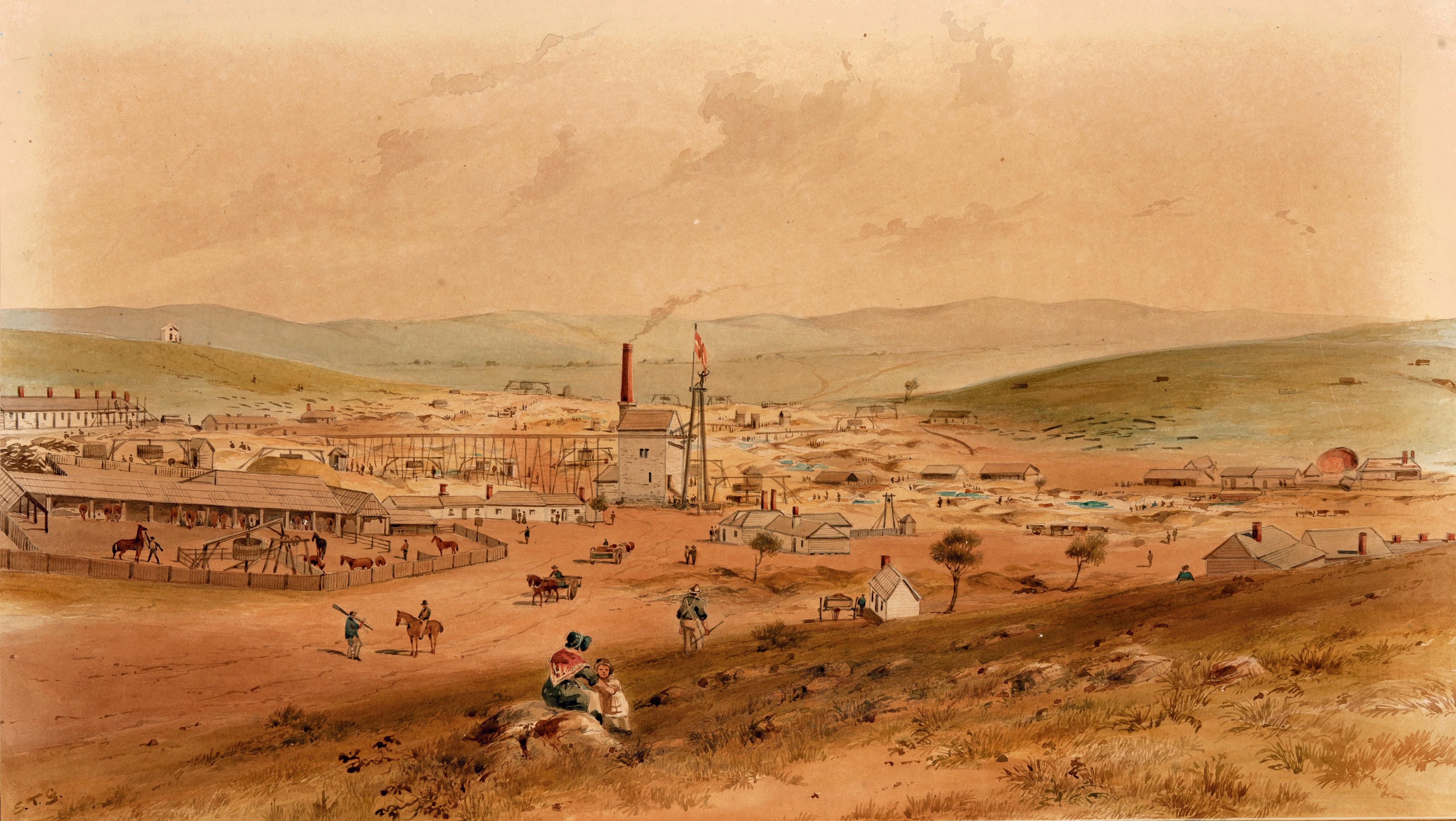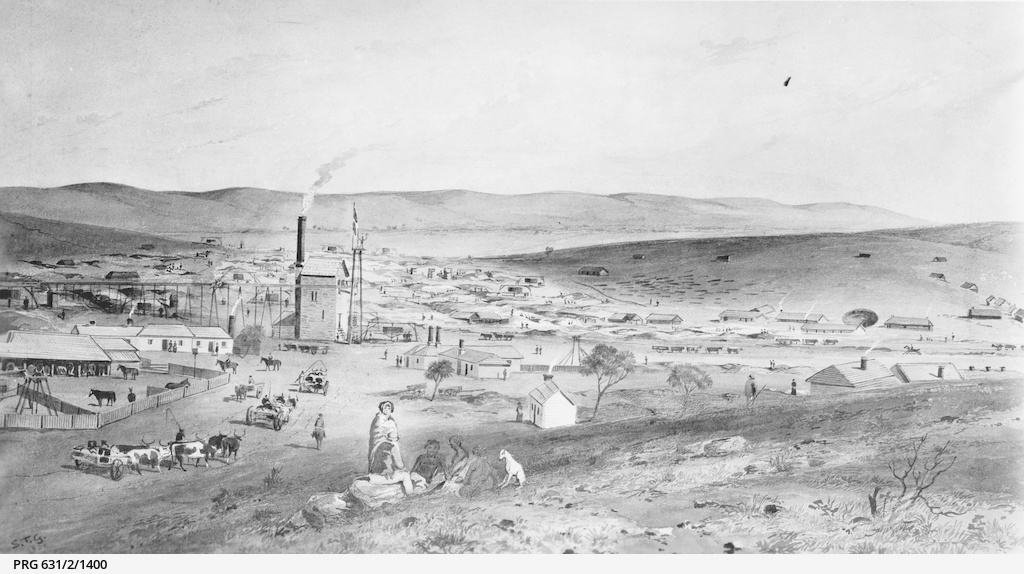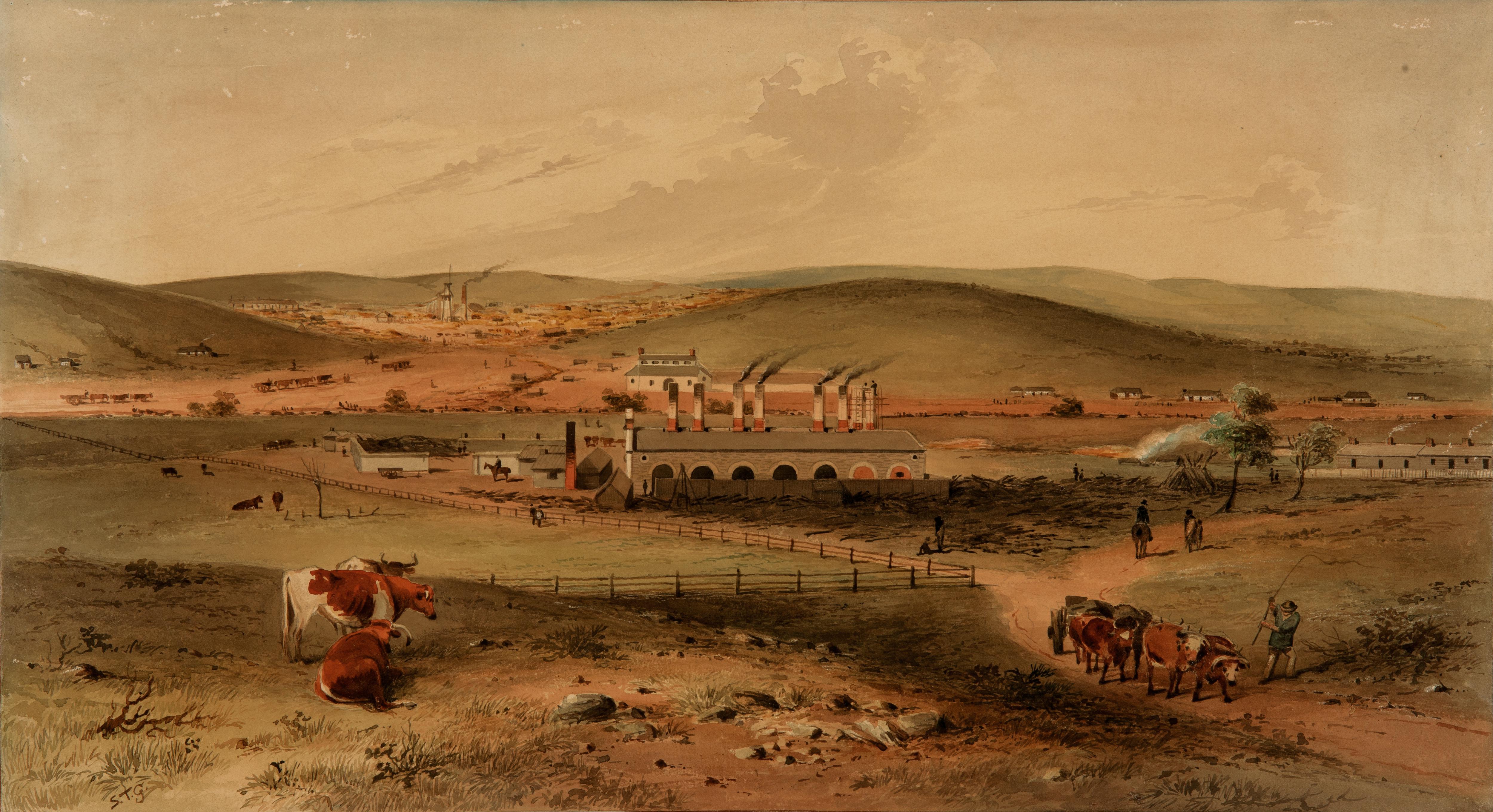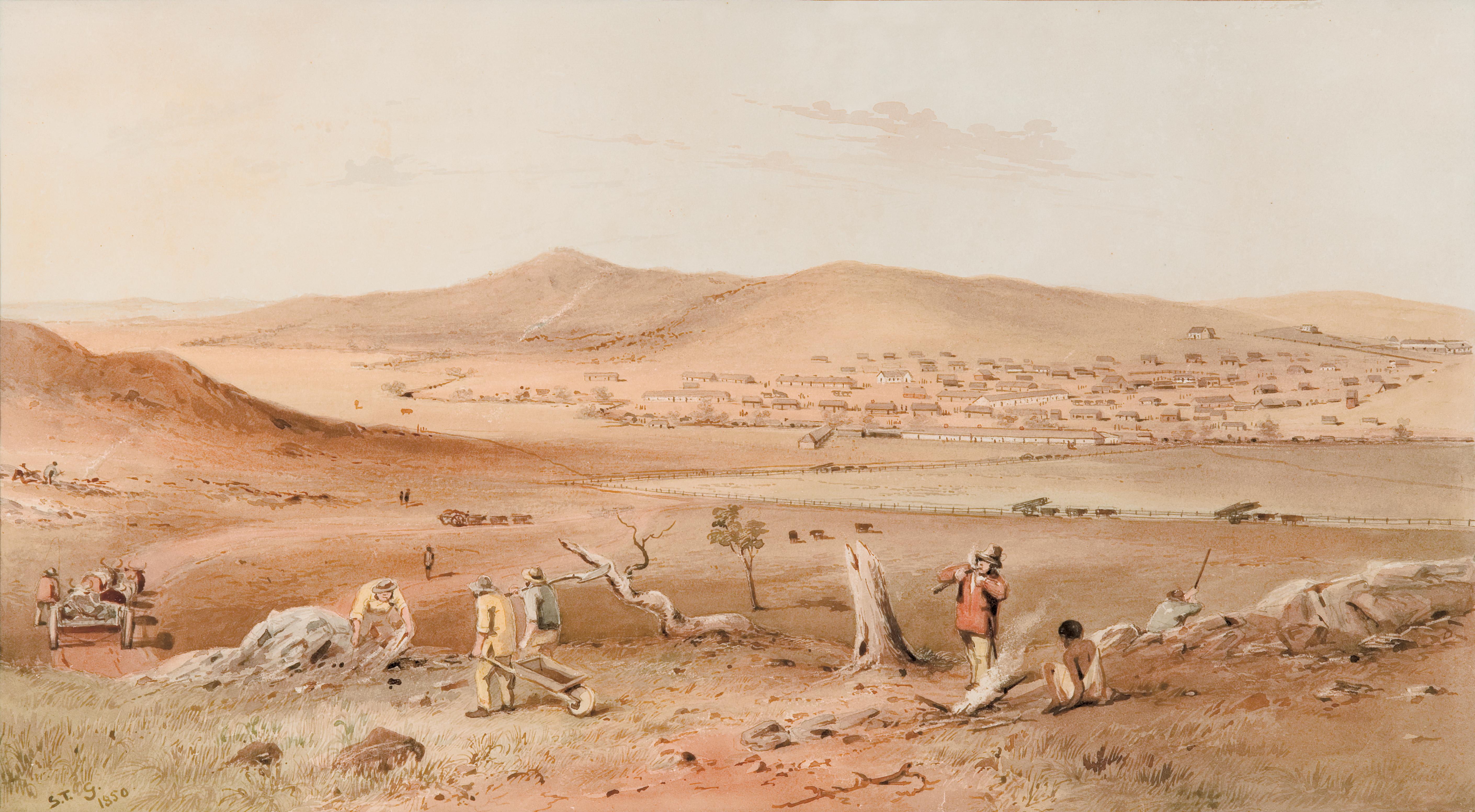 david coombe history
david coombe history
SUMMARY: Having painted seven views of Burra Burra Mine in April 1847 for the South Australian Mining Association (SAMA), S.T. Gill returned to refresh the views in February 1850. The updated scenes highlight new developments – the Patent Copper Company's smelting works and Roach's engine-house with its Cornish beam engine. Gill made three up-to-date above-ground views.
Article type: NARRATIVE, CATALOGUE & MAP
In this article ...
This is not a history of the Burra Burra Mine – that is thoroughly accomplished in Ian Auhl's The story of the 'Monster Mine' : the Burra Burra mine and its townships, 1845-1877 (see References below). I am dependent upon such authorities for much historical information. My main contribution through this article is to:
(Two other articles examine Gill's Burra views of 1845 and 1847 – links to these appear in this article.)
This map shows S.T. Gill's 1845, 1847 and 1850 pictures of the Burra Burra Mine and Township from their estimated viepoints. The map opens in another window and the reader may wish to have this at hand for reference.
Having painted seven views of Burra Burra Mine in April 1847 for the South Australian Mining Association (SAMA), Gill returned in 1850 to update them. After nearly three years the Burra Burra Mine was even more of an industrial environment and two new constructions now dominated the landscape – the Patent Copper Company's (PCC) smelting works and Roach's engine-house with its Cornish beam engine. Much less obvious was a new hilltop powder store,1 but Gill had made the previous temporary structure an obvious feature in his 1847 views, so the artist needed to rectify that too.
Construction was up, but confidence wasn't, mostly due to a huge miners' strike.
"The [miners'] strike which began in September 1848 ... was South Australia's first industrial strike – and almost certainly the earliest strike of any consequence in Australia. The strike made headline news for nearly three months ..." during which time the selling price for Burra shares crashed from £220 to £125. (Auhl 92)
Well, the deed is done. Four hundred miners are at this moment out of employ, and many of them, for aught we know to the contrary, houseless wanderers in this distant land, the victims of insatiable avarice or insufferable pride. What will strangers at a distance think of the stability of the Monster Mine, the eighth wonder of the world, the proprietors of which resolutely declined to pay their labourers more than 21s a-week, and their able-bodied miners 30s a-week, at the risk of suspending its lucrative operations, and of consequence depreciating the value of its shares, to say nothing of the danger and destruction rendered imminent by a cessation of the underground workings?2
The strike ended with victory for the employer, SAMA, under its secretary Henry Ayers. Ayers' took advantage of Adelaide's excess labour. Miners were replaced, some returned, some left for California.
Alluvial gold workings in California were reported in New South Wales as early as September 1848.3 News of the full rush was in the Sydney papers before Christmas. "The only item of interest is the news from the gold diggers – other matters receive no attention. The whole country is in a state of turmoil, and everybody is flying to the gold region to reap a fortune..."4
At first California's pull on South Australians was gentle.
In January 1849 the miners strike was reported over. At the same time steam pumping machinery for Burra had arrived from England. In February it was being carted from the Port and the smelting works were progressing well.5
That same month, February 1849, Gill executed Six Sectional Sketches at the Kapunda Copper Mine for E.C. Frome. They were aesthetic, detailed and accurate representations of mining operations.
Meanwhile at Burra, the Patent Copper Company's (PCC) smelting works was under construction east of the mine and across the creek and was in operation by June.6 There was already a smaller SAMA smelter (see Shute), but the PCC works meant more ore could be smelted near the mine site rather than in distant Adelaide or Wales.
Also new in 1849 was Roach's engine house and its Cornish beam engine. The steam engine transformed mining by pumping water out from greater depth than could be achieved by horse whims. It had begun operation on 20 October 1849.7 Steam now replaced horsepower.
Although the new smelting works was going, work still continued to add more furnaces. On 14 December 1849, a mason John Fox was working there when the thirty feet of scaffolding collapsed bringing down building stone and timber and crushing him. He died two days later. "His remains were conveyed to the cemetery, accompanied by an immense concourse of sorrowing spectators."8 Gill would seemingly allude in his view to this workplace death.
As 1850 began, California's pull became stronger. (Auhl 224)
CALIFORNIA. – Nearly a hundred and fifty Burra miners, were at the Port yesterday, bound for the land of gold.9
In another blow for SAMA, Samuel Stocks junior, a trustee, director and orginal founder, died on 3 February 1850. At 37, he was the same age as Gill. Only eight months earlier he'd been one of Gill's first "Heads of the People".
An obituary by John Stephens, in his Register newspaper, made reference to Stocks' intemperance, triggering a furore. Stocks had been widely liked and a petition to condemn the newspaper piece gained the signatures of nearly 200 prominent friends, Gill among them.10
Did conversation at Stocks' funeral prompt SAMA's directors to commission new Burra works from Gill? The 1847 paintings on the walls of the directors' room now appeared dated. Some optimism was needed.
So in February 1850 Gill made a return visit to Burra Burra.
S.T. Gill took three views:
The former two were 1847 subjects revisited from fresh viewpoints; the last was a new subject.
Gill likely heard about John Fox's crushing death at during his stay at the Burra, making his smelter view historical, detailed and sympathetic. It is pictured with the end two chimney stacks surrounded by scaffolding and two men atop.
An unidentified gentleman visited Burra Burra that month and presented a rosy view:
THE BURRA BURRA. – A gentleman who has just visited the Burra mine, writes us that the ore is if anything richer ... The Welsh smelters with whom he conversed, who have been engaged from their childhood in the same occupation, said they had never met with ores equal to those of the Burra mine. The springs are very strong from thirty fathoms downwards – one in particular had it been cut by the Artesian apparatus, would have risen well to the surface. The descent of the engine shaft from thence to its lowest point, ten feet below the forty fathom level, resembles an adventure in a storm, the noise of the pumping supplying whatever tumult might be required to complete the illusion. The engine works beautifully ...
The water ... is forced to the top of the engine-house, a total height of 300 feet, whence it falls into a reservoir, and is conducted to the neighbourhood of the various shafts for the washing of ores, and eventually into the Burra Creek, along which for a considerable distance are the jiggers of the halvans.11 Everything about the mine, above and below, gives evidence of order and good management – not a hand is idle, – not a point is neglected by which the vast property may be turned to the best account.
The Burra works are becoming more and more a town within themselves, and present an appearance similar to the gigantic establishments of older countries. A large yard is now walled round for the carpenters and the old smelting house is converted into a workshop for their use. On the opposite side is the store in which articles of every kind required for the workings are deposited. A very short walk leads to the smelting works of Messrs. Schneider & Co., which in their way are almost as surprising as the mine itself, especially when it is remembered that they have sprung up in little more than a year. When our informant was last at Kooringa about 15 months ago, Mr. Walters was on his first visit of inspection, and it was not decided, or at least not publicly known, that any such works
should have been undertaken in that locality. Besides the furnaces already at work, nine new ones are in the course of erection, and the flues of all will lead into a stack now building, which is eight feet square in the clear inside, and is to be 120 feet high ...
The visitor to the Burra mine cannot but be struck with the good fortune which attended the proprietory in the fixing of the bounds, or perhaps it may be more just to say, with the correct judgment of the surveyors who acted for them. The last workings are literally within a stone's throw of those belonging to the Bon Accord Company; yet the former yield Burra ore in its richest form, and the latter nothing but valueless stones with the green tinge of copper. The same may be said of the Princess Royal workings ...
The casual visitor at Kooringa cannot fail to notice the respectable and orderly character of the town and its inhabitants. This is particularly observable on the Sunday; there are no loungers – still less drunkards about the streets – all has the calm repose so especially indicative of an English Sabbath ...12
Gill completed his three views and SAMA paid him twelve guineas13 – presumably for the three picture series. And as in 1847 it seems some of SAMA's directors' also ordered their own copies. Keeping them true to life, the versions are the same in buildings and topography, but are unique in arrangement of the mobile elements – people, animals and vehicles.
The pictures generally have a decorative title in watercolour below the image and these would have been done by Gill.
Although Gill's 1847 Burra visit can be precisely dated from the lables, two dates are referenced for 1850 – 26th (AGSA 0.1352 & 0.1354) and 10th (Burra Regional Art Gallery) – perhaps the latter is a misreading.
There are two or three versions of each view extant in collections. Provenance of the pictures helps identify the original clients. I haven't been able to personally view any of these works to examine them, their backs or any decorative labels below the image. I particularly acknowledge the assistance of AGSA library with information on works which at the time of writing were not yet accessible from its online public catalogue.
To see these works, with accompanying notes, just scroll down or jump to the List of Works.
Appleyard, Ron. & Fargher, Barbara. & Radford, Ron. & Art Gallery of South Australia. (1986). S.T. Gill : the South Australian years, 1839-1852. Adelaide : Art Gallery of South Australia
Auhl, Ian. and Burra Burra (S.A.). Council. The story of the 'Monster Mine' : the Burra Burra mine and its townships, 1845-1877 / by Ian Auhl District Council of Burra Burra Burra, S. Aust 1986
Gill, S. T. and Ratcliffe, Julian. and Burra History Group. and Burra Regional Art Gallery. The S.T. Gill Collection, the Burra Regional Art Gallery Burra History Group, Burra, S. Aust. 2010.
Shute, Jason (2013). "When is a Store not a Store? When it's a Smelting House" By Jason Shute, Flinders University / Journal of Australasian Mining History, Vol. 11, October 2013 <http://www.samininghistory.com/wp-content/uploads/2014/11/shute-2014.pdf>
Gill, Samuel Thomas. and Auhl, Ian. and Marfleet, Denis. Australia's earliest mining era, South Australia 1841-1851 / Paintings by S.T. Gill ; by Ian Auhl and Denis Marfleet Rigby Adelaide 1975
1. The new powder magazine was ready by December 1847. Auhl 286.
2. South Australian Register, 15 November 1848: 2. <http://nla.gov.au/nla.news-article48727034>
3. Bathurst Advocate, 29 September 1848: 4. <http://nla.gov.au/nla.news-article62045325>
4. The Sydney Morning Herald, 23 December 1848: 3. <http://nla.gov.au/nla.news-article12910568>
5. South Australian, 20 February 1849: 2. <http://nla.gov.au/nla.news-article71623137>
6. South Australian Register, 6 June 1849: 4. <http://nla.gov.au/nla.news-article50245238>
7. South Australian Gazette and Mining Journal, 27 October 1849: 3. <http://nla.gov.au/nla.news-article195938719>
8. South Australian Register, 22 December 1849: 2. <http://nla.gov.au/nla.news-article50245522>
9. South Australian, 11 January 1850: 3. <http://nla.gov.au/nla.news-article71625445>
10. Some of the signatories later wrote that they hadn't realised the petition also committed signatories to "discountenance" the paper and didn't actually hold that position.
11. Jiggers and halvans are described in: Australian Town and Country Journal, 1 June 1872: 13. <http://nla.gov.au/nla.news-article70494899>
12. South Australian, 26 February 1850: 2. <http://nla.gov.au/nla.news-article71625737>
13. Minutes of SAMA board meetings, 30 August 1850, BRG 22/2, SLSA. (Shute 2013)
You can scroll down to see all pictures along with detailed notes or click a link to jump to a specific work from the list.
 Burra Burra Mine, S.A., showing chief portion of surface operations 1850 | Art Gallery of South Australia 0.1352
Burra Burra Mine, S.A., showing chief portion of surface operations 1850 | Art Gallery of South Australia 0.1352
Artist: Gill, S.T. | Date: 1850 | Appleyard cat. n/a | 32.8(H) x 57.5(W) cm
Catalogue: S.T. Gill and Burra Burra Mine 1850
VIEW: Surface Operations 1850
At centre is Roach's engine-house. At left is the hill top powder magazine which was ready in December 1847. Roach's steam engine began operation on 20 October 1849.
"Dated on label below ptg. pen & brown ink '...FEBY 26th 1850'". (AGSA)
Version: This version was for J.B. Graham. Provenance: Graham family, 1947.
Map | S. T. Gill - Burra
226
 Burra Burra Mine, Showing Main Portion of Surface Operations, 10th February 1850 | Burra Regional Art Gallery
Burra Burra Mine, Showing Main Portion of Surface Operations, 10th February 1850 | Burra Regional Art Gallery
Artist: Gill, S.T. | Date: 1850 | Appleyard cat. n/a | (H) x (W) cm
Catalogue: S.T. Gill and Burra Burra Mine 1850
For description see VIEW: Surface Operations 1850 (AGSA 0.1352).
Dated 10th February 1850 by Burra RAG (Ratcliffe, 2010) - this may be a misreading.
Version: Provenance: John Lewis 1916.
151
 Burra Burra Mine, S.A., showing chief portion of surface operations 1850 | State Library of South Australia PRG 631/2/1400
Burra Burra Mine, S.A., showing chief portion of surface operations 1850 | State Library of South Australia PRG 631/2/1400
Artist: Gill, S.T. | Date: 1850-02/1850 | Appleyard cat. n/a | 32.8(H) x 57.5(W) cm
Catalogue: S.T. Gill and Burra Burra Mine 1850
For description see VIEW: Surface Operations 1850 (AGSA 0.1352).
Version: The is a photograph of a painting, the original of which is unknown. This photo in SLSA was taken by Ernest Gall, probably in the 1890s. It is possibly connected with a photo of bust of Sir Henry Ayers [PRG 631/2/1845], suggesting the possibility that this version may have been for Henry Ayers, SAMA secretary.
418
 Patent Copper Company's Smelting Works and the Burra Burra Mine, 1850 | Art Gallery of South Australia 0.653
Patent Copper Company's Smelting Works and the Burra Burra Mine, 1850 | Art Gallery of South Australia 0.653
Artist: Gill, S.T. | Date: 1850 | Appleyard cat. 67 | 27.2(H) x 49.6(W) cm
Catalogue: S.T. Gill and Burra Burra Mine 1850
VIEW: PCC Smelting Works and Mine 1850
View of the Patent Copper Company's smelting works (foreground), the two storey SAMA storehouse (behind) and the Burra mining area with Roach's engine-house (background). The new smelting works were in operation by June 1849 but it continued to be extended. At the right end of the works, surrounded by scaffolding, two masons work on chimneys and the last two furnaces are closed.
Version: This is the original version for SA Mining Association. Provenance SAMA 1914.
I've used the same and more descriptive title for both AGSA 0.653 and 0.1350.
Map | S. T. Gill - Burra
234
 Burra Burra Mine, South Australia, from the rear of the P.C.C. Smelting Works | Art Gallery of South Australia 0.1350
Burra Burra Mine, South Australia, from the rear of the P.C.C. Smelting Works | Art Gallery of South Australia 0.1350
Artist: Gill, S.T. | Date: 1850-02 | Appleyard cat. 67.1 | 42.3(H) x 63.5(W) cm
Catalogue: S.T. Gill and Burra Burra Mine 1850
For description see VIEW: PCC Smelting Works and Mine 1850 (AGSA 0.653).
This painting has a label glued below: "Burra Burra Mine, So. Australia, from the rear of the P.C.C. Smelting Works, near Kooringa, Feby 26th 1850". The Patent Copper Company smelting works dominates the view; the mine is only in the distance. That this label is glued, and not part of the sheet as is the case for most other Gill Burra works, suggests a possiblity the wrong label may have been affixed, however this seems unlikely as there is no other work to better match the label. So it seems Gill's title reflects the relative importance of the subjects rather than their significance in the image.
Version: This version was for J.B. Graham. Provenance: Graham family, 1947.
I've used the same and more descriptive title for both AGSA 0.653 and 0.1350.
396
 Kooringa, the Burra Burra Township, from the Quarry at the rear of the P.C.C. Smelting Works | Art Gallery of South Australia 0.1354
Kooringa, the Burra Burra Township, from the Quarry at the rear of the P.C.C. Smelting Works | Art Gallery of South Australia 0.1354
Artist: Gill, S.T. | Date: 1850-02 | Appleyard cat. n/a | 42.5(H) x 63.8(W) cm
Catalogue: S.T. Gill and Burra Burra Mine 1850
For description see VIEW: Kooringa 1850 (AGSA 20063P13)
Version: This version was for J.B. Graham. Provenance: Graham family, 1947.
AGSA: Dated "Feby 26th 1850" on label below in pen & brown ink.
395
 Kooringa, the Burra Burra Township, from the Quarry at the rear of the P.C.C. Smelting Works | Art Gallery of South Australia 20063P13
Kooringa, the Burra Burra Township, from the Quarry at the rear of the P.C.C. Smelting Works | Art Gallery of South Australia 20063P13
Artist: Gill, S.T. | Date: 1850 | Appleyard cat. n/a | 27(H) x 49(W) cm
Catalogue: S.T. Gill and Burra Burra Mine 1850
VIEW: Kooringa 1850
At far right is the Burra Hotel on Commercial Road. Before it and up the slope is St. Mary's Anglican Church which is marked on the 1849 "rough plan".
Provenance: Ian Howard Lloyd 2006. A family connection suggests this version may have belonged originally to Henry Ayers. Provenance family of Ayers (Source: World of Antiques & Art, The, No. 74, Feb-Aug 2008: 168-169).
"In 1914 Mr. Lloyd was appointed liquidator of the [South Australian Mining] association. On the walls of his office are interesting sketches by S. T. Gill, an early day artist of note, in 1847." (The Advertiser, 19 February 1936: 21. <http://nla.gov.au/nla.news-article74158159>.)
Map | S. T. Gill - Burra
233
David Coombe, May 2022. Updated 14 March 2023. Formatted 4 January 2024. | text copyright (except where indicated)
CITE THIS: David Coombe, 2022-2023, S.T. Gill and Burra Burra Mine 1850, accessed dd mmm yyyy, <https://coombe.id.au/S_T_Gill/S_T_Gill_and_Burra_Burra_Mine_1850.htm>